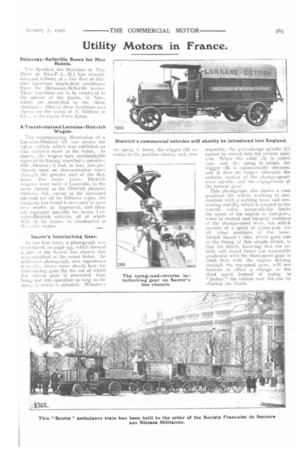Utility Motors in France.
Page 13

If you've noticed an error in this article please click here to report it so we can fix it.
Delaunay-Belleville Buses for Nice Hotels.
The Syndicat des Hoteliers de Nice (Gare de Nice-P.-L.-M.) has recently accepted delivery of a fine tleet of thirteen luxurious single-deck omnibuses from the Delaunay-Belleville works. These machines are to be employed in the service of the hotels, in Nice, which are controlled by the -,bove syndicate. One of these machines was shown on the stand of A. Vedrine et Cie. ct the recent Paris Salon.
A Travelstained Lorraine-Diet rich Wagon.
The accompanying illustration of a Lorraine-Dietrich tilt van shows the 4.h.p. vehicle which was exhibited on that maker's stand at the Salon. As shown, the wagon bore unmistakable signs of its having travelled a considerable distance; it had, in fact, just previously been on demonstration tours through the greater part of the Balkans. For 'many years, Dietrich wagon; were built at Lunevilie, in the same factory as the Dietrich pleasure vehicles, but, owing to the increased demand for all its different types, the company has found it necessary to open new works at Argenteuil, and these are equipped specially for heavy Lorraine-Dietrich vehicles, all of which will, in the future, be constructed at tHr •7ti.r works.
Saurer's Interlocking Gear.
In our last issue, a photograph was reprciuced, on page 335, which showed a part of the Saurer bus chassis that was exhibited at the recent Salon. An additional photograph, now reproduced herewith, shows more clearly how the interlocking gear (by the use of which the reverse gear is prevented from being put into operation so long as the spra;.: is down) is actuated. Whenevt r
the sprag is down, the trigger (B) remains in the position shown, and, con sequently, the gate-change spindle (C) cannot be moved into the reverse position. When the cable (A) is pulled taut, and the sprag is raised, the trigger (B) is automatically elevated, and it then no longer obstructs the endwise [notion of the change-speedlever spindle, and the engagement of the reverse gear.
This photograph also shows a cam quadrant (1)1 which, working in conjunction with a rocking lever and connecting rod (E), which is coupled to the throttle valve, automatically limits the speed of the engine to 7oor.p.m., when in neutral and top-gear positions of the change-speed lever, but which permits of a speed of 1,000r.p.m. for all other positions of the lever. Adolph Saurer's idea, which gave rise to the fitting of this simple device, is that the driver, knowing that the vehick will travel faster (on reasonable gradients) with the third-speed gear in mesh than with the engine driving through the top-speed gear, will not hesitate to effect a change to the third speed instead of trying to "jockey." the vehicle over the rise by :lipping the clutch.
























